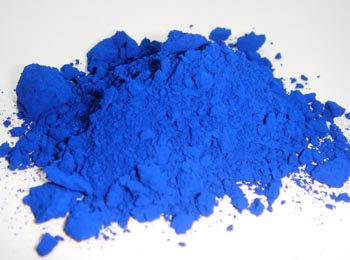pigment

Prussian Blue.
A pigment is a chemical substance that imparts color. In animals important pigments include melanin (black), rhodopsin (purple), and the respiratory pigments, hemoglobin (red) and hemocyanin (blue). In plants, the chlorophylls (green) are important photosynthetic pigments. Other plant pigments, sometimes called accessory pigments, include the carotenes and xanthophylls (red-yellow), the anthocyanins (red-blue), and the anthoxanthins (yellow-orange). Among the roles of accessory pigments is to extend the range of light wavelengths useful in photosynthesis. In nature, whiteness results from the absence of pigment (as in the case of albinos) and is comparatively uncommon.
Although both pigments and dyes are colored materials, they have rather different properties and in consequence have different functions when uses to color fabrics and other materials. The chief distinction is that dyes penetrate the fibers of the substance to be colored and in so doing the dye becomes permanently fixed into the material. In contrast pigments are insoluble materials which are applied to a surface and can be removed from it by mechanical means.
Prussian blue
Prussian blue, iron (III) hexacyanoferrate(II) (Fe4[Fe(CN)6]3), also called ferricyanide or ferric ferrocyanide, is a deep-blue paint pigment. The pigment was once used as a source of hydrocyanic acid, hence its former prussic acid.


